Optimization of Machining Parameters for Corner Accuracy Improvement for WEDM Processing
Abstract
1. Introduction
2. Methodology
2.1. Experiment Condition and Equipment
2.2. Response Surface Methodology
3. Experiment and Discussion
3.1. Effect of Parameter on Corner Error
3.1.1. Effect of Pulse-on Time (ON) on Corner Error
3.1.2. Effect of Pulse-off Time (OFF) on Corner Error
3.1.3. Effect of Open Circuit Voltage (OV) on Corner Error
3.1.4. Effect of Servo Voltage (SV) on Corner Error
3.1.5. Effect of Wire Tension (WT) on Corner Error
3.1.6. Effect of Flushing Pressure (WA) on Corner Error
3.2. Optimization
4. Human–Machine Interface
- Input the machining parameters code (shown at area 1 in Figure 10), then choose the predict button. The system will calculate the corner error value for 30°, 60°, 90° corners and the machining speed (shown at area 2 in Figure 10) based on regression Equations (3)–(6). The system also calculates and displays the smallest corner error values. (Area 3 in Figure 10.)
- Check whether the predicted error value is within the allowable error range. If the predicted error value is larger than the tolerance error, optimization process will be executed.
- For corner optimization, the system will extract the value in the required accuracy textbox and store it in another variable. Furthermore, use “For Loop” to bring all the parameter ranges into the regression Equations (3)–(5) to calculate all parameter sets, and then store the calculation results in the temporary array matrix 1. Subsequently, use “Foreach” statement to compare the stored calculation results in the temporary array matrix 1 one by one to search for the parameters set that meets the desirable corner error value, and store these parameters in the array matrix 2.
- Afterward, the parameters in the array matrix 2 are brought into the machining time regression equation (Equation (6)), and the system calculates the machining time and searches the parameters set for the fastest machining time, and then displays them on the optimized parameters (shown at area 4 in Figure 10).
- Finally, the best parameters can be stored in a CSV format.
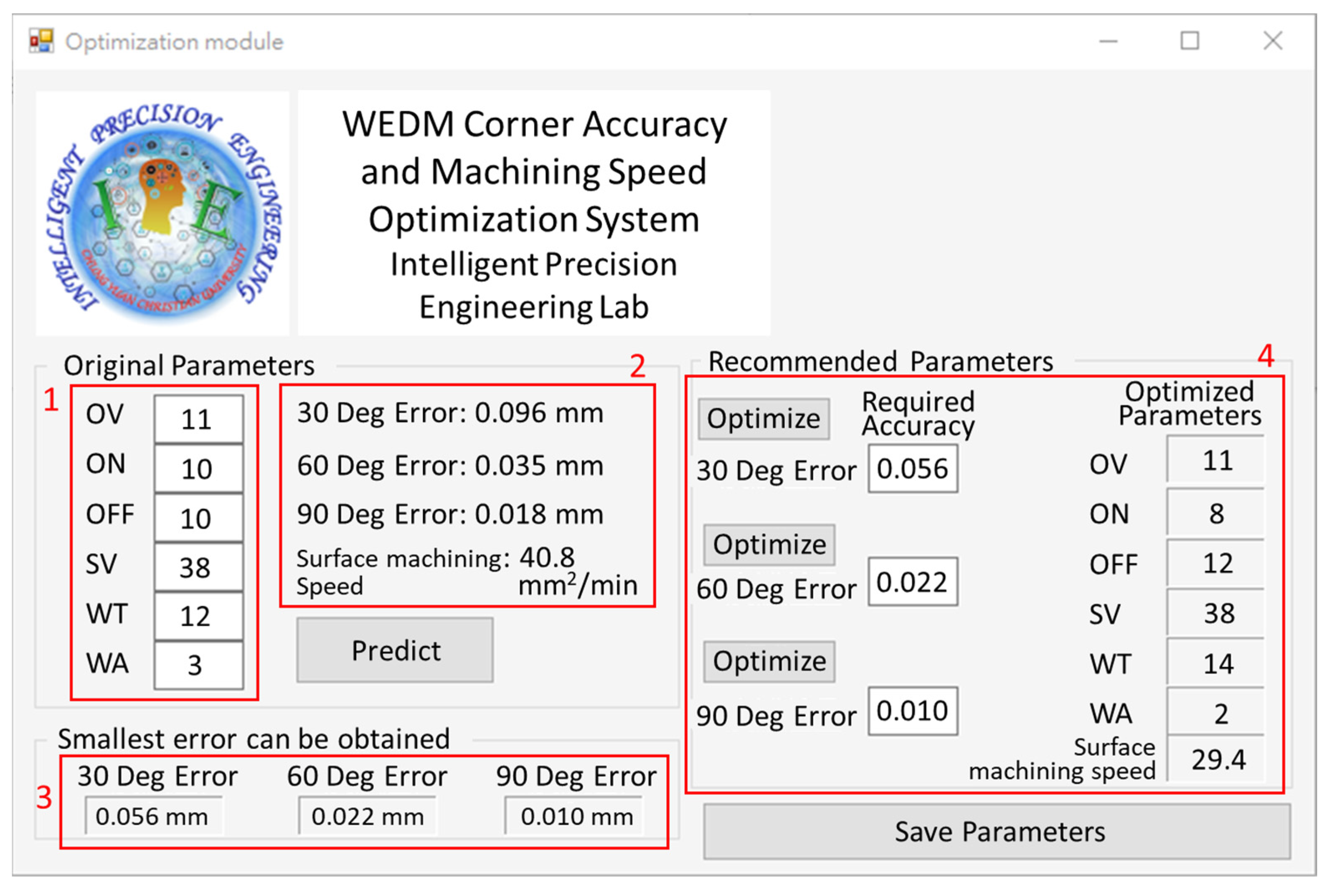
5. Verification Experiments
6. Conclusions
Author Contributions
Funding
Conflicts of Interest
References
- Bhattacharya, A.; Batish, A.; Bhatt, G. Material transfer mechanism during magnetic field-assisted electric discharge machining of AISI D2, D3 and H13 die steel. Proc. Inst. Mech. Eng. Manuf. 2015, 229, 62–74. [Google Scholar] [CrossRef]
- Sanchez, J.A.; Rodil, J.L.; Herrero, A.; Lopez de Lacalle, L.N.; Lamikiz, A. On the influence of cutting speed limitation on the accuracy of wire-EDM corner-cutting. J. Mater. Process. Technol. 2007, 182, 574–579. [Google Scholar] [CrossRef]
- Selvakumar, G.; Sarkar, S.; Mitra, S. Experimental Investigation on die corner accuracy for wire electrical discharge machining of monel 400 alloy. Proc. IMechE Part B J. Eng. Manuf. 2012, 226, 1694–1704. [Google Scholar] [CrossRef]
- Saravanan, M.; Babu, A.S. Parametric optimization of increasing corner accuracy in WEDM on Inconel 625. J. Chem. Pharm. Sci. 2015, 9, 443–447. [Google Scholar]
- Han, F.; Zhang, J.; Soichiro, I. Corner error simulation of rough cutting in wire EDM. Precis. Eng. 2007, 31, 331–336. [Google Scholar] [CrossRef]
- Hsue, W.J.; Liao, Y.S.; Lu, S.S. Fundamental geometry analysis of wire electrical discharge machining in corner cutting. Int. J. Mach. Tools Manuf. 1999, 39, 651–667. [Google Scholar] [CrossRef]
- Dekeyser, W.L.; Snoeys, R. Geometrical accuracy of wire-EDM. In Proceedings of the 9th International Symposium on Electro Machining, Nagoya, Japan, 10–14 April 1989. [Google Scholar]
- Obara, H.; Kawai, T.; Ohsumi, T.; Hatano, M. Combined power and path control method to improve corner accuracy of rough cuts by wire EDM (1st report). Int. J. Electr. Mach. 2003, 8, 27–32. [Google Scholar]
- Obara, H.; Kawai, T.; Ohsumi, T.; Hatano, M. Combined power and path control method to improve corner accuracy of rough cuts by wire EDM (2nd report). Int. J. Electr. Mach. 2003, 8, 33–38. [Google Scholar]
- Chaudhari, R.; Prajapati, P.; Khanna, S.; Vora, J.; Patel, V.K.; Pimenov, D.Y.; Giasin, K. Multi-response optimization of Al2O3 nanopowder-mixed wire electrical discharge machining process parameters of nitinol shape memory alloy. Materials 2022, 15, 2018. [Google Scholar] [CrossRef]
- Pandey, G.K.; Patel, P.B.; Kumar, A.; Niranjan, R.S.; Katiyar, V.; Chandra, A.K. Effect of different wire materials on WEDM performance of bio-compatible material. Prod. Eng. Arch. 2022, 28, 50–55. [Google Scholar] [CrossRef]
- Chen, Z.; Zhou, H.; Wu, C.; Zhang, G.; Yan, H. A new wire electrode for improving the machining characteristics of high-volume fraction SiCp/Al composite in WEDM. Materials 2022, 15, 4098. [Google Scholar] [CrossRef] [PubMed]
- Elyass, W.M.; Sharma, V.; Kantak, G.; Alam, M.M. Performance investigation of wireEDM process parameters. IOP Conf. Ser. Mater. Sci. Eng. 2022, 1224, 012001. [Google Scholar] [CrossRef]
- Puri, A.B.; Bhattacharyya, B. An analysis and optimization of the geometrical inaccuracy due to wire lag phenomenon in WEDM. Int. J. Mach. Tools Manuf. 2003, 43, 151–159. [Google Scholar] [CrossRef]
- Lodhi, B.K.; Agarwal, S. Optimization of machining parameters in WEDM of AISI D3 steel using Taguchi technique. Procidia CIRP 2014, 14, 194–199. [Google Scholar] [CrossRef]
- Kam, M.; Demirtas, M. Analysis of tool vibration and surface roughness during turning process of tempered steel samples using Taguchi method. Proc. Inst. Mech. Eng. E J. Process. Mech. Eng. 2021, 235, 1429–11438. [Google Scholar] [CrossRef]
- Singh, V.; Pradhan, S.K. Optimization of WEDM parameters using Taguchi technique and response surface methodology in machining of AISI D2 steel. Procidia Eng. 2014, 97, 1597–1608. [Google Scholar] [CrossRef]
- Kam, M.; Ipekci, A.; Argun, K. Experiment investigation and optimization of machining process of deep cryogenically treated and tempered steels in electrical discharge machining process. Proc. Inst. Mech. Eng. E J. Process. Mech. Eng. 2022, 236, 1927–1935. [Google Scholar] [CrossRef]
- Kam, M. Effect of deep cryogenic treatment on machinability, hardness and microstructure in dry turning process of tempered steels. Proc. Inst. Mech. Eng. E J. Process. Mech. Eng. 2021, 235, 927–936. [Google Scholar] [CrossRef]
- Mir, M.J.; Sheikh, K.; Singh, B.; Malhotra, N. Modeling and analysis of machining parameters for surface roughness in powder mixed EDM using RSM approach. Int. J. Eng. Sci. Technol. 2012, 4, 45–52. [Google Scholar] [CrossRef]
- Doreswamy, D.; Shreyas, D.S.; Bhat, S.K.; Rao, R.N. Optimization of material removal rate and surface characterization of wire electric discharge machined Ti-6Al-4V alloy by response surface method. Manuf. Rev. 2022, 9, 15. [Google Scholar] [CrossRef]
- Saha, A.; Mondal, S.C. Multi-objective optimization in WEDM process of nanostructured hardfacing materials through hybrid techniques. Measurement 2016, 94, 46–59. [Google Scholar] [CrossRef]
- Kumar, S.S.; Uthayakumar, M.; Kumaran, S.T.; Parameswaran, P.; Mohandas, E.; Kempulraj, G.; Ramesh Babu, B.S.; Natarajan, S.A. Parametric optimization of wire electrical discharge machining on aluminum-based composites through grey relational analysis. J. Manuf. Process. 2015, 20, 33–39. [Google Scholar] [CrossRef]
- Chalisgaonkar, R.; Kumar, J. Multi-response optimization and modeling of trim cut WEDM operation of commercially pure titanium (CPTi) considering multiple user’s preference. Eng. Sci. Technol. Int. J. 2015, 18, 125–134. [Google Scholar] [CrossRef]
- Myersm, R.H.; Montgomery, D.C.; Anderson-cook, C.M. Response Surface Methodology: Process and Product Optimization Using Designed Experiment; John Wiley and Sons, Inc.: Hoboken, NJ, USA, 2009. [Google Scholar]
- Ferreira, S.L.C.; Bruns, R.E.; Ferreira, H.S.; Matos, G.D.; David, J.M.; Brandão, G.C.; da Silva, E.G.P.; Portugal, L.A.; dos Reis, P.S.; Souza, A.S.; et al. Box-Behnken design: An alternative for the optimization of analytical methods. Anal. Chim. Acta 2007, 597, 179–186. [Google Scholar] [CrossRef] [PubMed]
- Amini, M.; Younesi, H.; Bahramifar, N.; Lorestani, A.A.Z.; Ghorbani, F.; Daneshi, A.; Sharifzadeh, M. Application of response surface methodology for optimization of lead biosorption in an aqueous solution by aspergillus niger. J. Hazard. Mater. 2008, 154, 694–702. [Google Scholar]
- Kalavathy, M.H.; Regupathi, I.; Pillai, M.G.; Miranda, L.R. Modelling, analysis and optimization of adsorption parameters for H3PO4 activated rubber wood sawdust using response surface methodology (RSM). Colloids Surf. B 2009, 70, 35–40. [Google Scholar] [CrossRef]
- Le Man, H.; Behera, S.K.; Park, H.S. Optimization of operational parameters for ethanol production from Korean food waste leachate. Int. J. Environ. Sci. Technol. 2010, 7, 157–164. [Google Scholar] [CrossRef]
- Singh, M.A.; Joshi, K.; Hanzel, O.; Singh, R.; Sajgalik, P.; Marla, D. Influence of open voltage and servo voltage during Wire-EDM of silicon carbides. Procedia CIRP Conf. Electro Phys. Chem. Mach. 2020, 95, 285–289. [Google Scholar] [CrossRef]
- Vala, U.H.; Sama, M.R. A review on different effects on flushing of dielectric fluid in WEDM. Int. J. Adv. Res. Sci. Eng. 2017, 6, 37–44. [Google Scholar]
- Mondal, S.K.; Saha, A.K.; Sinha, A. Removal of ciprofloxacin using modified advanced oxidation processes: Kinetics, pathways and process optimization. J. Clean. Prod. 2018, 171, 1203–1214. [Google Scholar] [CrossRef]
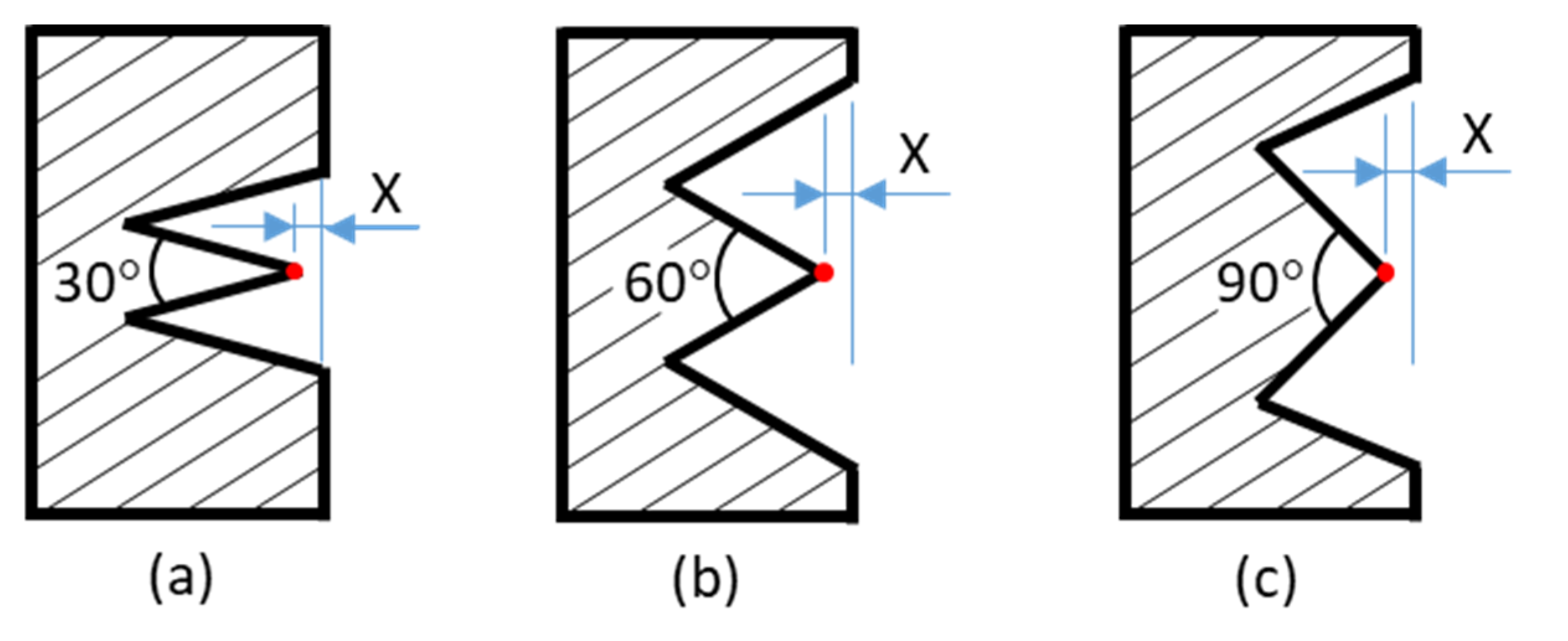
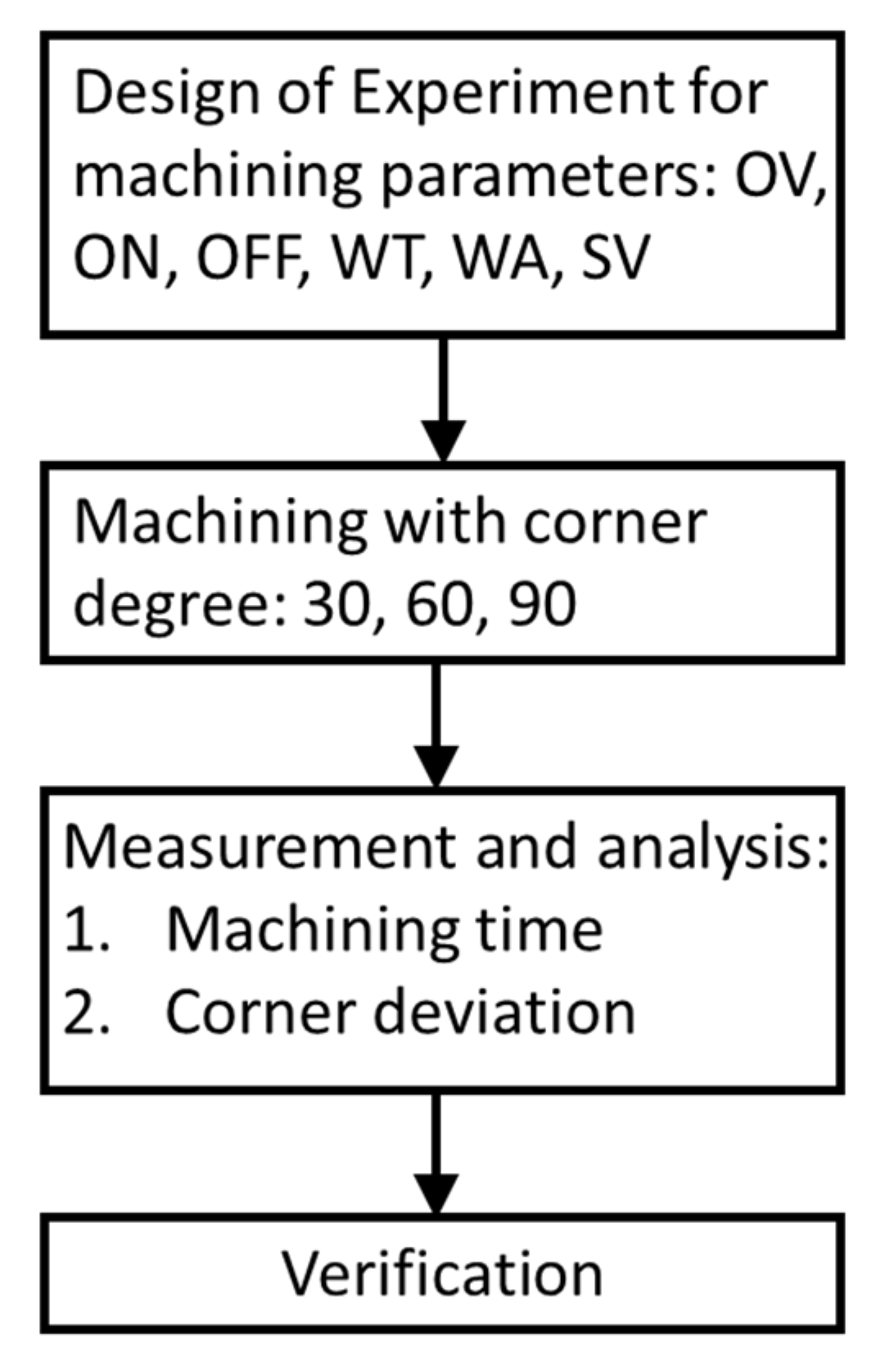
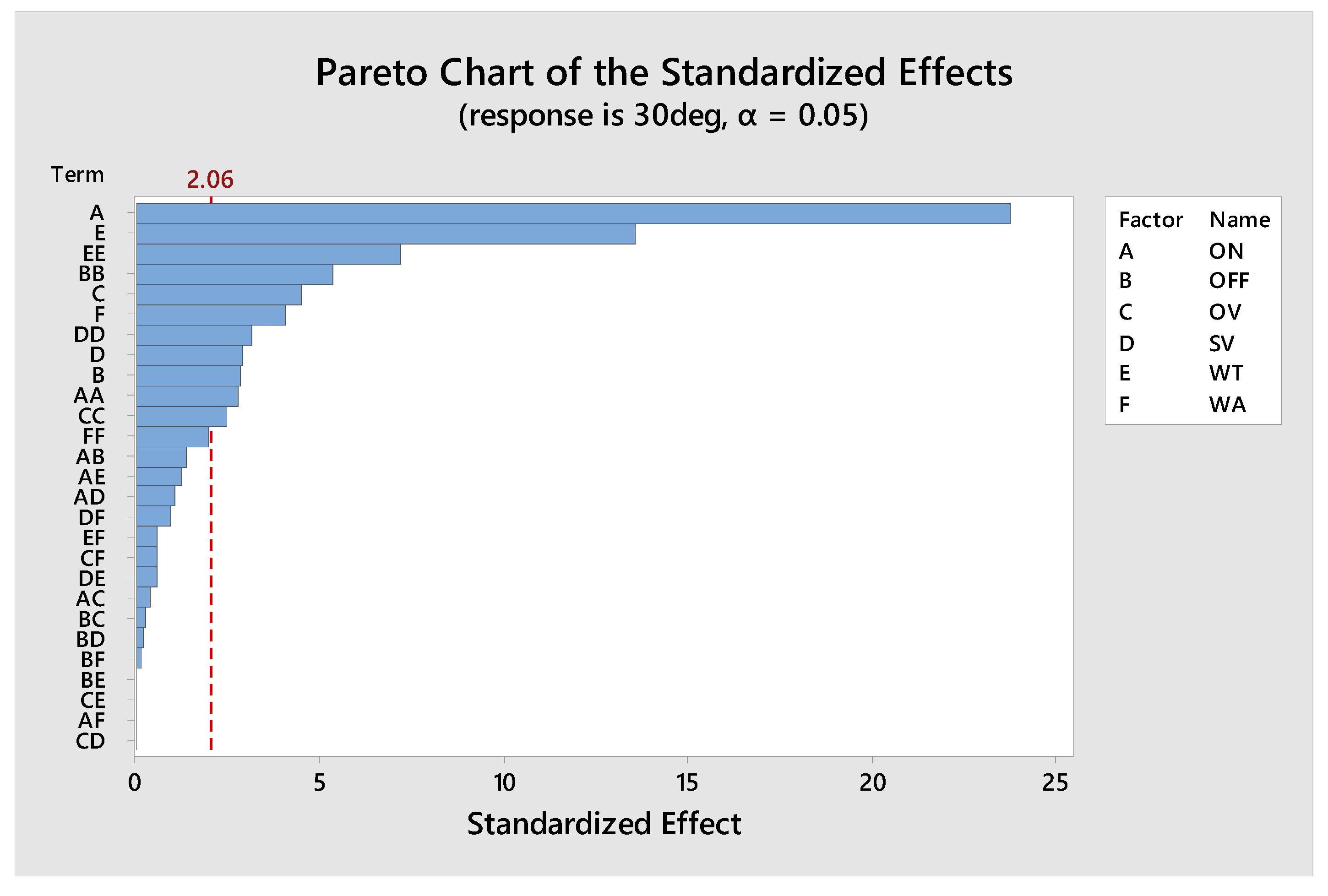

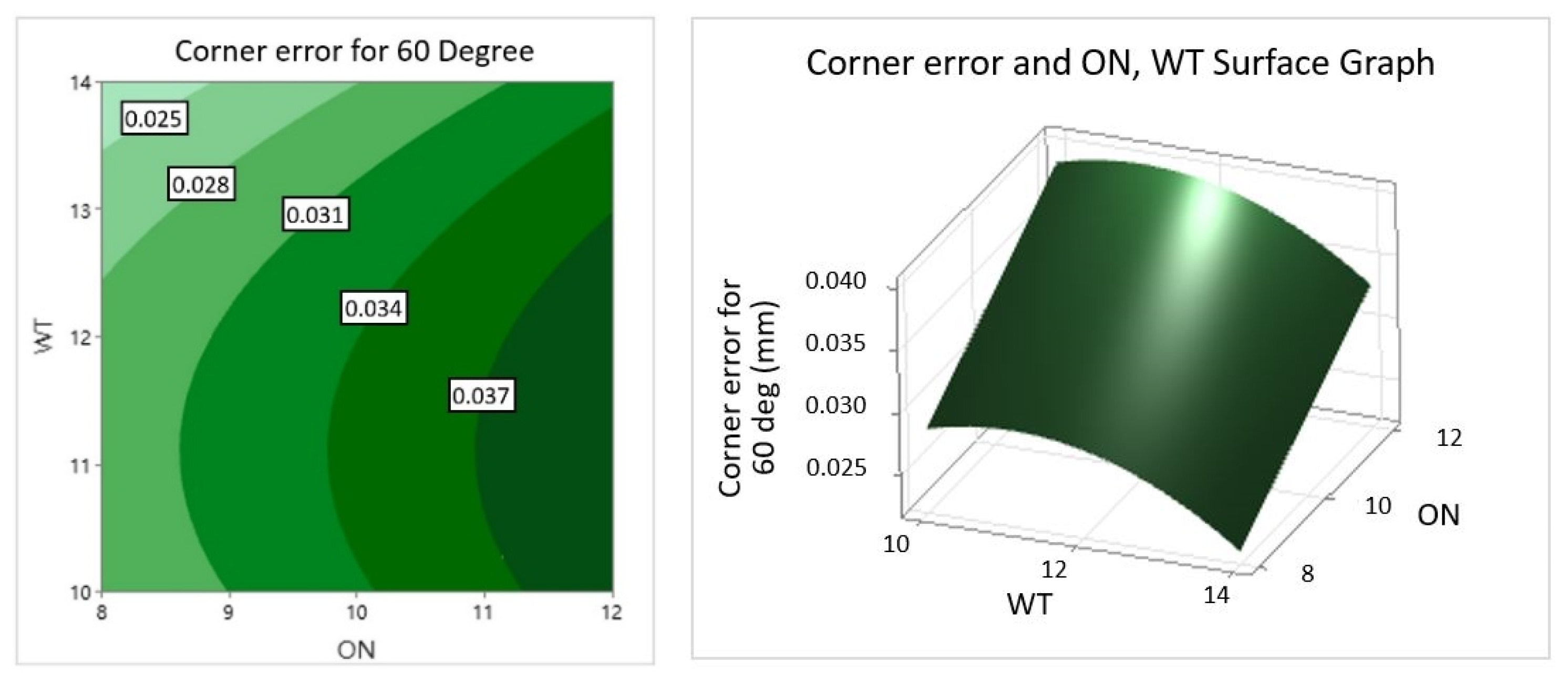
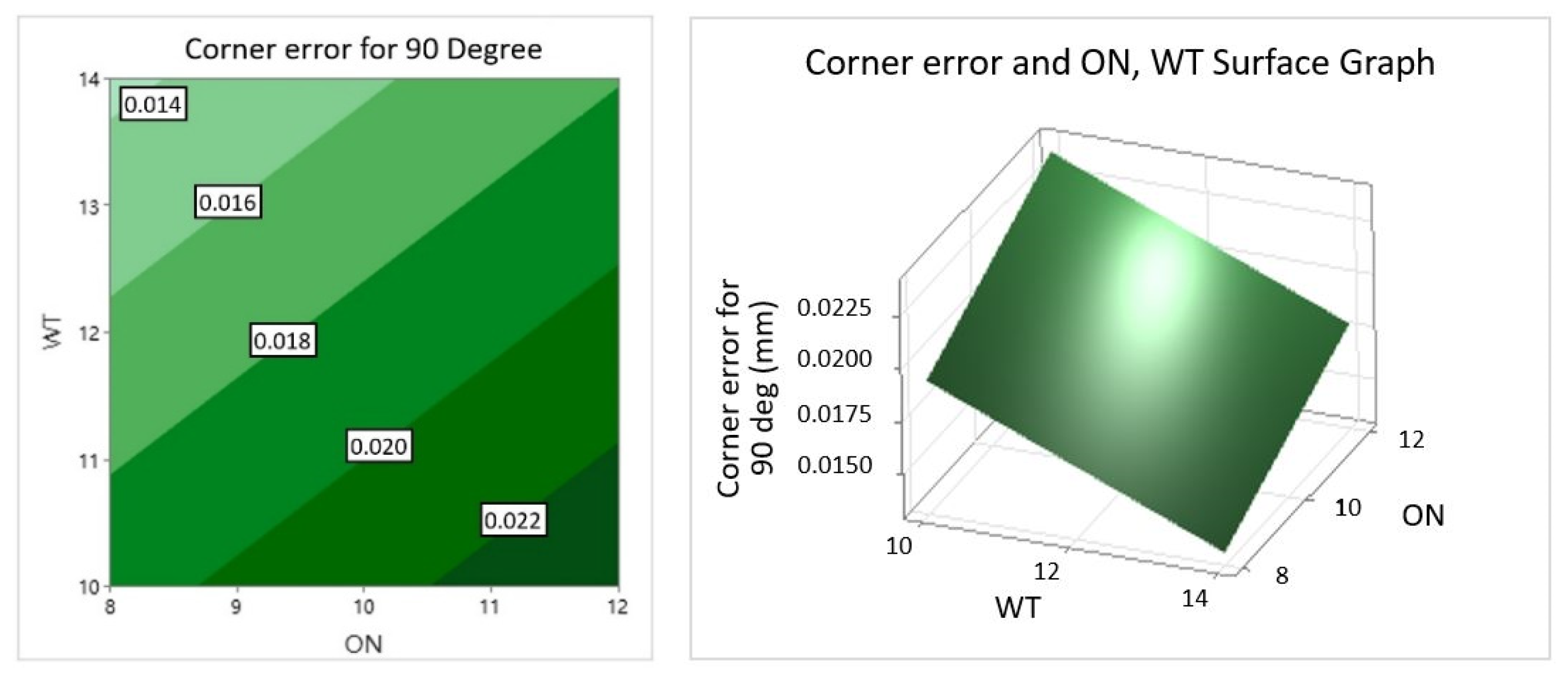
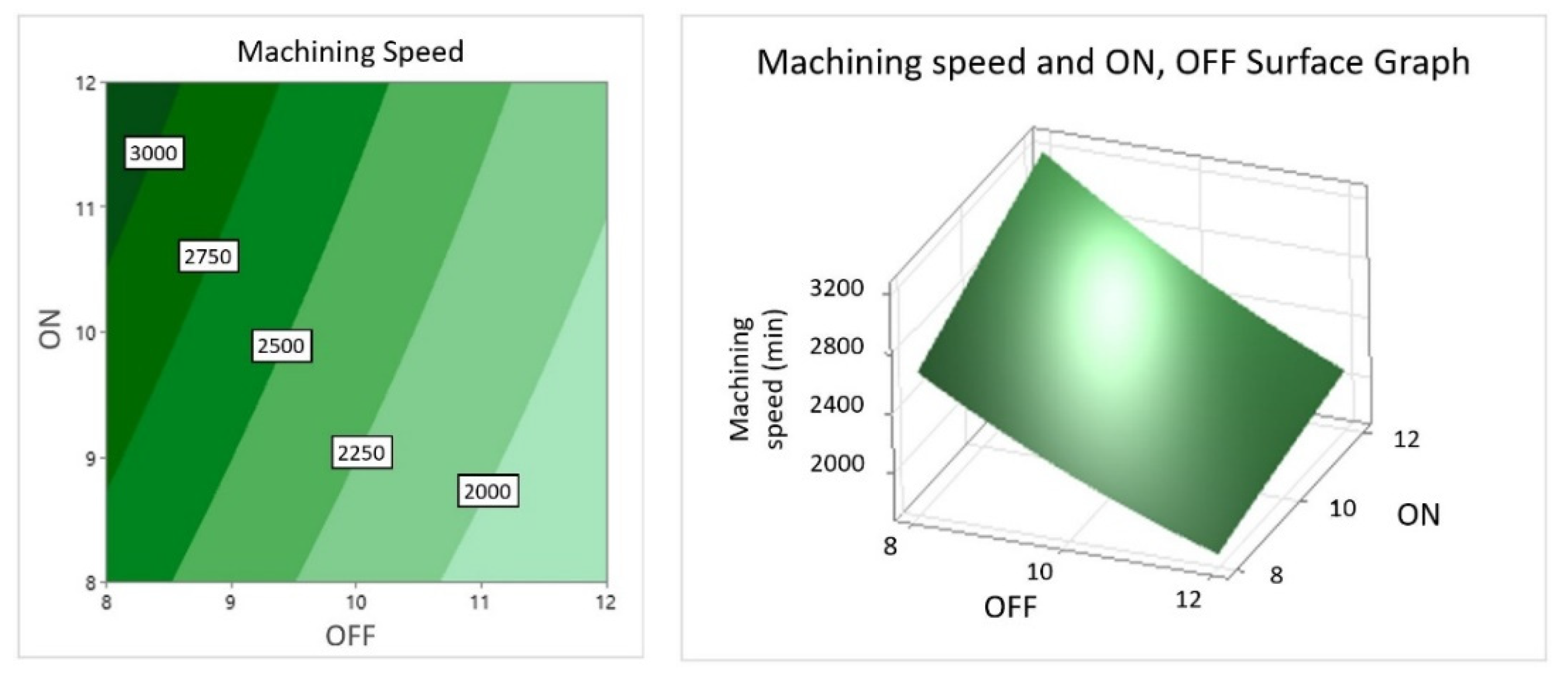
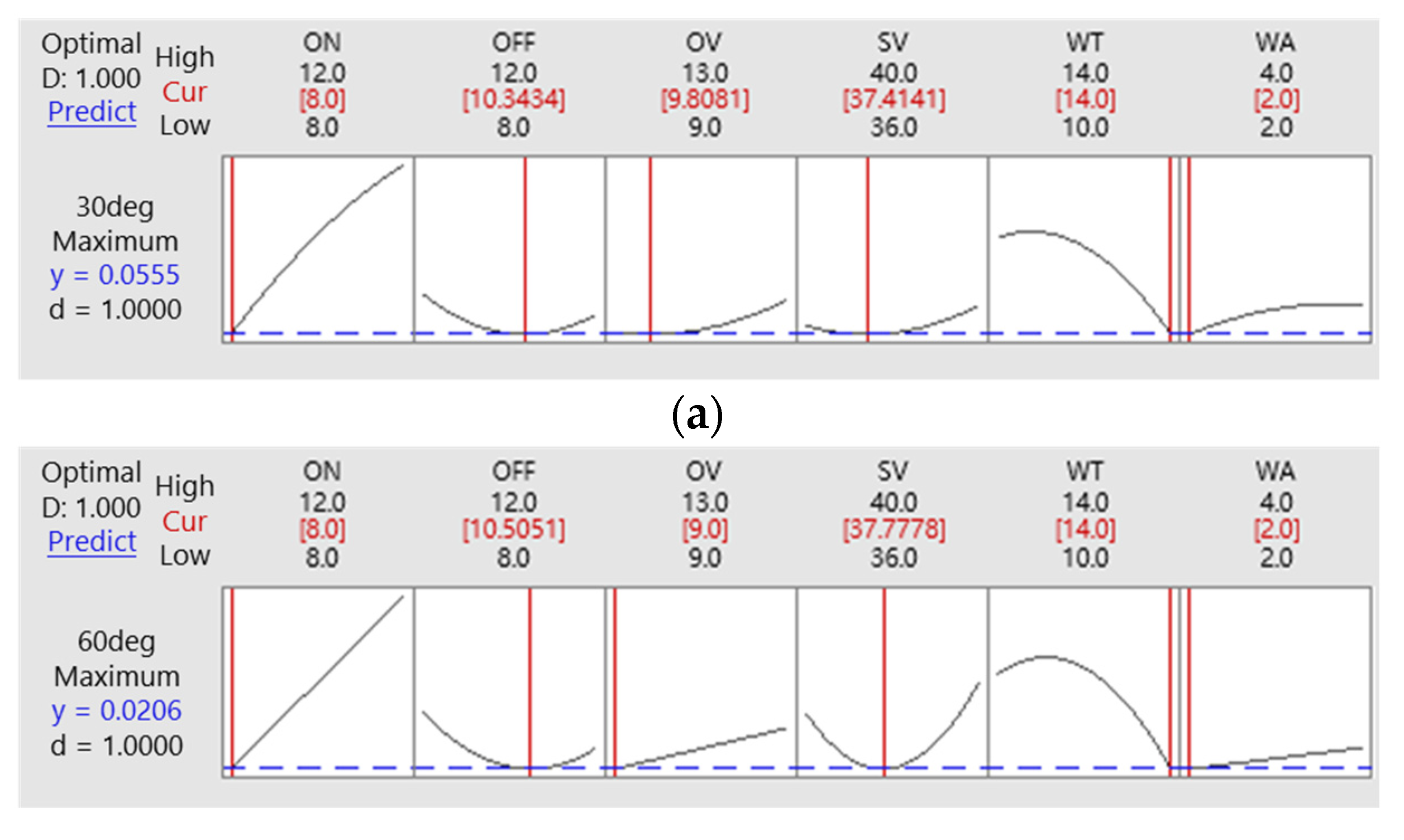
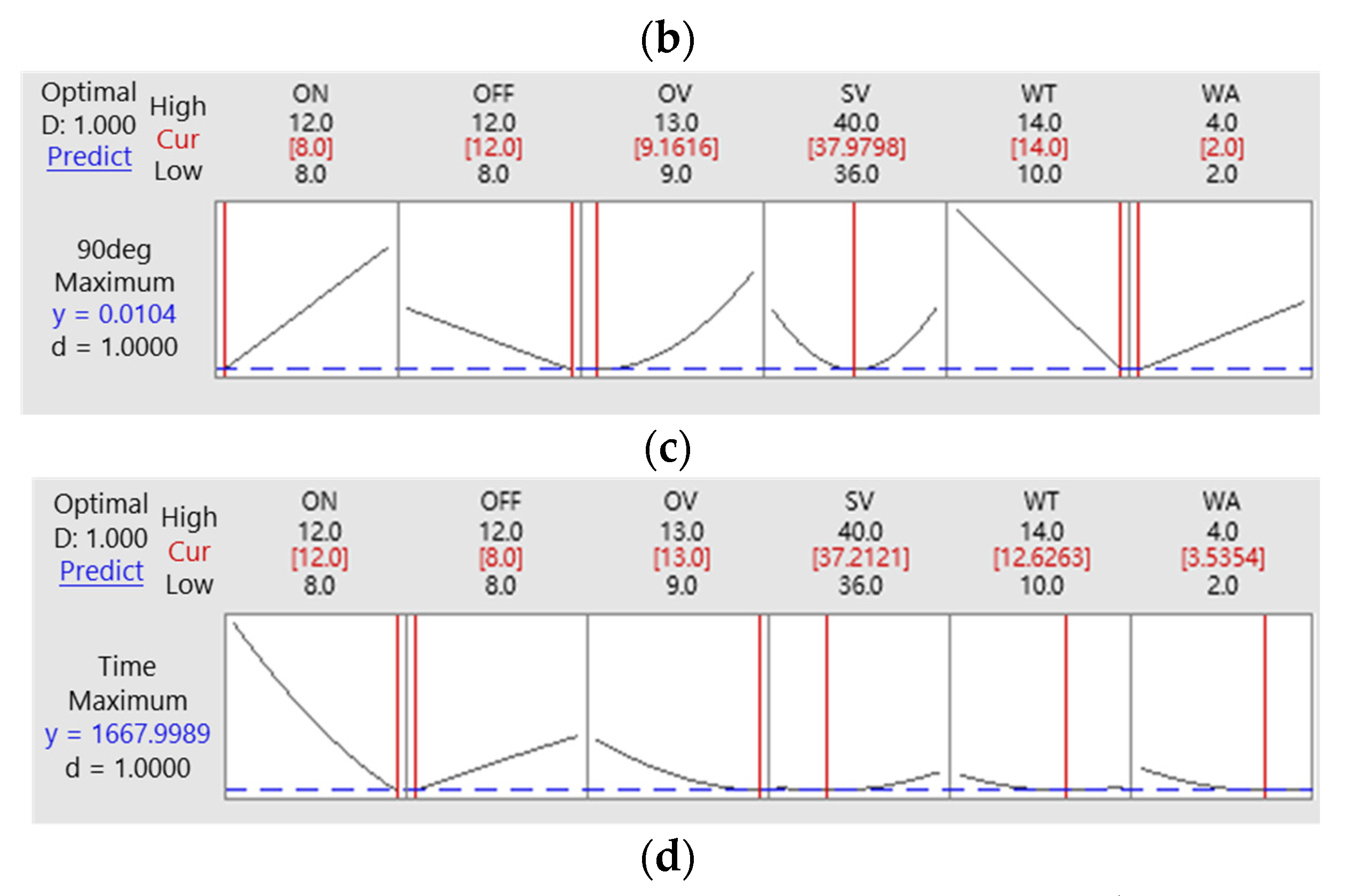
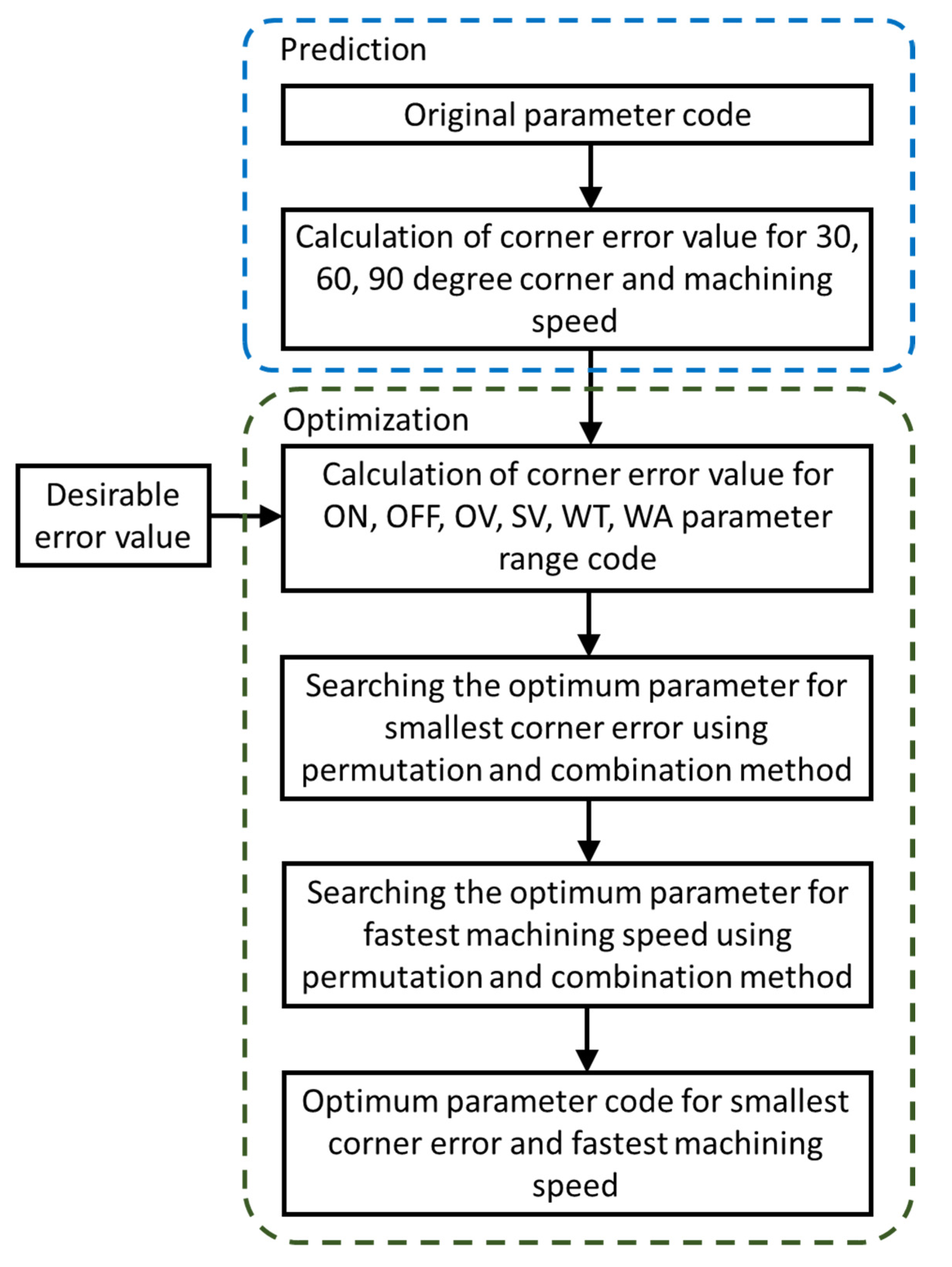
| Parameter | Level (Code) | Code Level/Value Range | ||
|---|---|---|---|---|
| Low | Mid | High | ||
| OV | 9 | 11 | 13 | 1–32 (level)/50–140 V |
| ON | 8 | 10 | 12 | 1–24 (level)/50–1200 ns |
| OFF | 8 | 10 | 12 | 4–50 (level)/4–50 μs |
| SV | 36 | 38 | 40 | 16–75 (level)/16–75 V |
| WT | 10 | 12 | 14 | 1–20 (level)/300–2200 g |
| WA | 2 | 3 | 4 | 1–8 (level)/increase or decrease proportionally |
| OV | ON | OFF | SV | WT | WA |
|---|---|---|---|---|---|
| 11 | 10 | 10 | 38 | 12 | 3 |
| 13 | 10 | 8 | 38 | 12 | 4 |
| 9 | 10 | 12 | 38 | 12 | 2 |
| 11 | 10 | 8 | 40 | 12 | 2 |
| 11 | 8 | 12 | 38 | 14 | 3 |
| 11 | 12 | 10 | 38 | 14 | 4 |
| 9 | 10 | 8 | 38 | 12 | 4 |
| 13 | 10 | 12 | 38 | 12 | 2 |
| 13 | 10 | 10 | 36 | 14 | 3 |
| 9 | 12 | 10 | 36 | 12 | 3 |
| 13 | 10 | 12 | 38 | 12 | 4 |
| 9 | 10 | 10 | 40 | 10 | 3 |
| 11 | 10 | 10 | 38 | 12 | 3 |
| 9 | 8 | 10 | 40 | 12 | 3 |
| 11 | 12 | 8 | 38 | 10 | 3 |
| 13 | 8 | 10 | 40 | 12 | 3 |
| 11 | 12 | 12 | 38 | 14 | 3 |
| 11 | 10 | 10 | 38 | 12 | 3 |
| 11 | 10 | 12 | 36 | 12 | 2 |
| 9 | 10 | 10 | 36 | 10 | 3 |
| 11 | 10 | 8 | 36 | 12 | 4 |
| 9 | 12 | 10 | 40 | 12 | 3 |
| 9 | 8 | 10 | 36 | 12 | 3 |
| 11 | 8 | 10 | 38 | 10 | 2 |
| 11 | 8 | 10 | 38 | 10 | 4 |
| 11 | 8 | 10 | 38 | 14 | 4 |
| 13 | 10 | 10 | 40 | 10 | 3 |
| 11 | 10 | 10 | 38 | 12 | 3 |
| 13 | 10 | 10 | 40 | 14 | 3 |
| 13 | 8 | 10 | 36 | 12 | 3 |
| 11 | 12 | 10 | 38 | 14 | 2 |
| 9 | 10 | 10 | 40 | 14 | 3 |
| 13 | 10 | 8 | 38 | 12 | 2 |
| 11 | 10 | 12 | 40 | 12 | 2 |
| 11 | 10 | 10 | 38 | 12 | 3 |
| 11 | 12 | 10 | 38 | 10 | 4 |
| 11 | 10 | 12 | 36 | 12 | 4 |
| 11 | 8 | 8 | 38 | 14 | 3 |
| 11 | 10 | 8 | 36 | 12 | 2 |
| 11 | 8 | 12 | 38 | 10 | 3 |
| 11 | 10 | 10 | 38 | 12 | 3 |
| 11 | 10 | 12 | 40 | 12 | 4 |
| 9 | 10 | 10 | 36 | 14 | 3 |
| 9 | 10 | 8 | 38 | 12 | 2 |
| 13 | 12 | 10 | 36 | 12 | 3 |
| 11 | 8 | 8 | 38 | 10 | 3 |
| 13 | 10 | 10 | 36 | 10 | 3 |
| 11 | 8 | 10 | 38 | 14 | 2 |
| 9 | 10 | 12 | 38 | 12 | 4 |
| 11 | 10 | 8 | 40 | 12 | 4 |
| 11 | 12 | 8 | 38 | 14 | 3 |
| 11 | 12 | 12 | 38 | 10 | 3 |
| 11 | 12 | 10 | 38 | 10 | 2 |
| 13 | 12 | 10 | 40 | 12 | 3 |
| Source | Sum of Squares | df | Mean Square | F-Value | p-Value (Prob > F) | Remarks |
|---|---|---|---|---|---|---|
| Model | 0.008290 | 27 | 0.000307 | 33.31 | <0.0001 | Significant |
| ON | 0.005228 | 1 | 0.005228 | 567.18 | <0.0001 | Significant |
| OFF | 0.000076 | 1 | 0.000076 | 8.28 | 0.0079 | Significant |
| OV | 0.000188 | 1 | 0.000188 | 20.41 | 0.0001 | Significant |
| SV | 0.000077 | 1 | 0.000077 | 8.36 | 0.0077 | Significant |
| WT | 0.001702 | 1 | 0.001702 | 184.68 | <0.0001 | Significant |
| WA | 0.000154 | 1 | 0.000154 | 16.67 | 0.0004 | Significant |
| ON OFF | 0.000018 | 1 | 0.000018 | 1.95 | 0.1741 | |
| ON OV | 0.000002 | 1 | 0.000002 | 0.17 | 0.6813 | |
| ON SV | 0.000011 | 1 | 0.000011 | 1.15 | 0.2943 | |
| ON WT | 0.000015 | 1 | 0.000015 | 1.64 | 0.2115 | |
| ON WA | 0.000000 | 1 | 0.000000 | 0.00 | 0.9969 | |
| OFF OV | 0.000001 | 1 | 0.000001 | 0.06 | 0.8028 | |
| OFF SV | 0.000000 | 1 | 0.000000 | 0.05 | 0.8177 | |
| OFF WT | 0.000000 | 1 | 0.000000 | 0.00 | 0.9523 | |
| OFF WA | 0.000000 | 1 | 0.000000 | 0.02 | 0.8930 | |
| OV SV | 0.000000 | 1 | 0.000000 | 0.00 | 1.0000 | |
| OV WT | 0.000000 | 1 | 0.000000 | 0.00 | 0.9847 | |
| OV WA | 0.000003 | 1 | 0.000003 | 0.36 | 0.5530 | |
| SV WT | 0.000003 | 1 | 0.000003 | 0.34 | 0.5654 | |
| SV WA | 0.000008 | 1 | 0.000008 | 0.87 | 0.3601 | |
| WT WA | 0.000003 | 1 | 0.000003 | 0.36 | 0.5526 | |
| ON2 | 0.000070 | 1 | 0.000070 | 7.64 | 0.0103 | Significant |
| OFF2 | 0.000263 | 1 | 0.000263 | 28.54 | <0.0001 | Significant |
| OV2 | 0.000056 | 1 | 0.000056 | 6.12 | 0.0203 | Significant |
| SV2 | 0.000091 | 1 | 0.000091 | 9.84 | 0.0042 | Significant |
| WT2 | 0.000478 | 1 | 0.000478 | 51.85 | <0.0001 | Significant |
| WA2 | 0.000037 | 1 | 0.000037 | 4.03 | 0.0552 | |
| Residual | 0.000240 | 26 | 0.000009 | |||
| Lack-of-Fit | 0.000191 | 21 | 0.000009 | 0.94 | 0.5919 | |
| Pure Error | 0.000048 | 5 | 0.000010 | |||
| Cor. Total | 0.008529 | 53 |
| Source | Sum of Squares | df | Mean Square | F-Value | p-Value (Prob > F) | Remarks |
|---|---|---|---|---|---|---|
| Model | 0.001396 | 27 | 0.000052 | 7.95 | <0.0001 | Significant |
| ON | 0.000647 | 1 | 0.000647 | 99.50 | <0.0001 | Significant |
| OFF | 0.000028 | 1 | 0.000028 | 4.27 | 0.0490 | Significant |
| OV | 0.000036 | 1 | 0.000036 | 5.53 | 0.0266 | Significant |
| SV | 0.000022 | 1 | 0.000022 | 3.39 | 0.0770 | |
| WT | 0.000196 | 1 | 0.000196 | 30.22 | <0.0001 | Significant |
| WA | 0.000010 | 1 | 0.000010 | 1.50 | 0.2316 | |
| ON OFF | 0.000001 | 1 | 0.000001 | 0.17 | 0.6808 | |
| ON OV | 0.000029 | 1 | 0.000029 | 4.48 | 0.0440 | Significant |
| ON SV | 0.000000 | 1 | 0.000000 | 0.01 | 0.9226 | |
| ON WT | 0.000005 | 1 | 0.000005 | 0.69 | 0.4130 | |
| ON WA | 0.000001 | 1 | 0.000001 | 0.21 | 0.6478 | |
| OFF OV | 0.000013 | 1 | 0.000013 | 1.94 | 0.1760 | |
| OFF SV | 0.000003 | 1 | 0.000003 | 0.48 | 0.4943 | |
| OFF WT | 0.000002 | 1 | 0.000002 | 0.29 | 0.5965 | |
| OFF WA | 0.000002 | 1 | 0.000002 | 0.34 | 0.5623 | |
| OV SV | 0.000002 | 1 | 0.000002 | 0.31 | 0.5839 | |
| OV WT | 0.000000 | 1 | 0.000000 | 0.01 | 0.9307 | |
| OV WA | 0.000000 | 1 | 0.000000 | 0.08 | 0.7858 | |
| SV WT | 0.000000 | 1 | 0.000000 | 0.08 | 0.7837 | |
| SV WA | 0.000000 | 1 | 0.000000 | 0.08 | 0.7837 | |
| WT WA | 0.000000 | 1 | 0.000000 | 0.05 | 0.8297 | |
| ON2 | 0.000005 | 1 | 0.000005 | 0.72 | 0.4024 | |
| OFF2 | 0.000051 | 1 | 0.000051 | 7.88 | 0.0094 | Significant |
| OV2 | 0.000008 | 1 | 0.000008 | 1.22 | 0.2799 | |
| SV2 | 0.000219 | 1 | 0.000219 | 33.69 | <0.0000 | Significant |
| WT2 | 0.000102 | 1 | 0.000102 | 15.63 | 0.0005 | Significant |
| WA2 | 0.000000 | 1 | 0.000000 | 0.06 | 0.8056 | |
| Residual | 0.000169 | 26 | 0.000007 | |||
| Lack-of-Fit | 0.000151 | 21 | 0.000007 | 2.04 | 0.2197 | |
| Pure Error | 0.000018 | 5 | 0.000004 | |||
| Cor. Total | 0.001565 | 53 |
| Source | Sum of Squares | df | Mean Square | F-Value | p-Value (Prob > F) | Remarks |
|---|---|---|---|---|---|---|
| Model | 0.000586 | 27 | 0.000022 | 5.15 | <0.0001 | Significant |
| ON | 0.000115 | 1 | 0.000115 | 27.19 | <0.0001 | Significant |
| OFF | 0.000029 | 1 | 0.000029 | 6.81 | 0.0149 | Significant |
| OV | 0.000075 | 1 | 0.000075 | 17.78 | 0.0003 | Significant |
| SV | 0.000038 | 1 | 0.000038 | 9.00 | 0.0059 | Significant |
| WT | 0.000197 | 1 | 0.000197 | 46.82 | <0.0001 | Significant |
| WA | 0.000035 | 1 | 0.000035 | 8.26 | 0.0080 | Significant |
| ON OFF | 0.000001 | 1 | 0.000001 | 0.27 | 0.6097 | |
| ON OV | 0.000000 | 1 | 0.000000 | 0.06 | 0.8025 | |
| ON SV | 0.000000 | 1 | 0.000000 | 0.00 | 0.9840 | |
| ON WT | 0.000000 | 1 | 0.000000 | 0.02 | 0.8870 | |
| ON WA | 0.000002 | 1 | 0.000002 | 0.56 | 0.4621 | |
| OFF OV | 0.000003 | 1 | 0.000003 | 0.65 | 0.4288 | |
| OFF SV | 0.000000 | 1 | 0.000000 | 0.03 | 0.8646 | |
| OFF WT | 0.000001 | 1 | 0.000001 | 0.16 | 0.6910 | |
| OFF WA | 0.000000 | 1 | 0.000000 | 0.00 | 0.9501 | |
| OV SV | 0.000000 | 1 | 0.000000 | 0.12 | 0.7332 | |
| OV WT | 0.000001 | 1 | 0.000001 | 0.27 | 0.6097 | |
| OV WA | 0.000000 | 1 | 0.000000 | 0.04 | 0.8470 | |
| SV WT | 0.000011 | 1 | 0.000011 | 2.64 | 0.1162 | |
| SV WA | 0.000002 | 1 | 0.000002 | 0.47 | 0.4969 | |
| WT WA | 0.000001 | 1 | 0.000001 | 0.29 | 0.5979 | |
| ON2 | 0.000005 | 1 | 0.000005 | 1.28 | 0.2685 | |
| OFF2 | 0.000000 | 1 | 0.000000 | 0.01 | 0.9144 | |
| OV2 | 0.000010 | 1 | 0.000010 | 2.42 | 0.1318 | |
| SV2 | 0.000056 | 1 | 0.000056 | 13.31 | 0.0012 | Significant |
| WT2 | 0.000001 | 1 | 0.000001 | 0.35 | 0.5615 | |
| WA2 | 0.000003 | 1 | 0.000003 | 0.67 | 0.4195 | |
| Residual | 0.000110 | 26 | 0.000004 | |||
| Lack-of-Fit | 0.000094 | 21 | 0.000004 | 1.47 | 0.3562 | |
| Pure Error | 0.000015 | 5 | 0.000003 | |||
| Cor. Total | 0.000695 | 53 |
| Corner Degree | ON Parameter (Code) Corner Error (mm) | ||
|---|---|---|---|
| 8 | 10 | 12 | |
| 30° | 0.076 | 0.091 | 0.101 |
| 60° | 0.029 | 0.034 | 0.041 |
| 90° | 0.018 | 0.022 | 0.023 |
| Corner Degree | OFF Parameter (Code) Corner Error (mm) | ||
|---|---|---|---|
| 8 | 10 | 12 | |
| 30° | 0.103 | 0.093 | 0.088 |
| 60° | 0.040 | 0.038 | 0.035 |
| 90° | 0.027 | 0.025 | 0.024 |
| Corner Degree | OV Parameter (Code) Corner Error (mm) | ||
|---|---|---|---|
| 9 | 11 | 13 | |
| 30° | 0.090 | 0.093 | 0.099 |
| 60° | 0.035 | 0.035 | 0.040 |
| 90° | 0.020 | 0.020 | 0.021 |
| Corner Degree | SV Parameter (Code) Corner Error (mm) | ||
|---|---|---|---|
| 36 | 38 | 40 | |
| 30° | 0.092 | 0.094 | 0.097 |
| 60° | 0.031 | 0.035 | 0.042 |
| 90° | 0.017 | 0.018 | 0.024 |
| Corner Degree | WT Parameter (Code) Corner Error (mm) | ||
|---|---|---|---|
| 10 | 12 | 14 | |
| 30° | 0.102 | 0.090 | 0.086 |
| 60° | 0.036 | 0.034 | 0.025 |
| 90° | 0.029 | 0.021 | 0.017 |
| Corner Degree | WA Parameter (Code) Corner Error (mm) | ||
|---|---|---|---|
| 2 | 3 | 4 | |
| 30° | 0.089 | 0.098 | 0.109 |
| 60° | 0.035 | 0.036 | 0.037 |
| 90° | 0.023 | 0.024 | 0.025 |
| Parameter | 30° Corner | 60° Corner | 90° Corner | |||
|---|---|---|---|---|---|---|
| Original Parameter | Optimized Parameter | Original Parameter | Optimized Parameter | Original Parameter | Optimized Parameter | |
| OV | 11 | 10 | 11 | 11 | 11 | 11 |
| ON | 10 | 8 | 10 | 8 | 10 | 8 |
| OFF | 10 | 11 | 10 | 10 | 10 | 12 |
| SV | 38 | 37 | 38 | 38 | 38 | 38 |
| WT | 12 | 14 | 12 | 14 | 12 | 14 |
| WA | 3 | 2 | 3 | 2 | 3 | 2 |
| Corner Degree | Predicted Corner Error (mm) | Measured Corner Error (mm) | Prediction Accuracy (%) |
|---|---|---|---|
| 30 | 0.096 | 0.091 | 94 |
| 60 | 0.035 | 0.030 | 86 |
| 90 | 0.018 | 0.018 | 99 |
| Corner Degree | Predicted Corner Error (mm) | Measured Corner Error (mm) | Prediction Accuracy (%) |
|---|---|---|---|
| 30 | 0.056 | 0.056 | 99 |
| 60 | 0.022 | 0.024 | 91 |
| 90 | 0.010 | 0.011 | 90 |
| Corner Degree | Corner Error before Optimization (mm) | Corner Error after Optimization (mm) | Improvement Accuracy (%) |
|---|---|---|---|
| 30 | 0.091 | 0.056 | 39 |
| 60 | 0.030 | 0.024 | 20 |
| 90 | 0.018 | 0.011 | 33 |
Publisher’s Note: MDPI stays neutral with regard to jurisdictional claims in published maps and institutional affiliations. |
© 2022 by the authors. Licensee MDPI, Basel, Switzerland. This article is an open access article distributed under the terms and conditions of the Creative Commons Attribution (CC BY) license (https://creativecommons.org/licenses/by/4.0/).
Share and Cite
Wang, S.-M.; Wu, J.-X.; Gunawan, H.; Tu, R.-Q. Optimization of Machining Parameters for Corner Accuracy Improvement for WEDM Processing. Appl. Sci. 2022, 12, 10324. https://doi.org/10.3390/app122010324
Wang S-M, Wu J-X, Gunawan H, Tu R-Q. Optimization of Machining Parameters for Corner Accuracy Improvement for WEDM Processing. Applied Sciences. 2022; 12(20):10324. https://doi.org/10.3390/app122010324
Chicago/Turabian StyleWang, Shih-Ming, Jia-Xuan Wu, Hariyanto Gunawan, and Ren-Qi Tu. 2022. "Optimization of Machining Parameters for Corner Accuracy Improvement for WEDM Processing" Applied Sciences 12, no. 20: 10324. https://doi.org/10.3390/app122010324
APA StyleWang, S.-M., Wu, J.-X., Gunawan, H., & Tu, R.-Q. (2022). Optimization of Machining Parameters for Corner Accuracy Improvement for WEDM Processing. Applied Sciences, 12(20), 10324. https://doi.org/10.3390/app122010324








